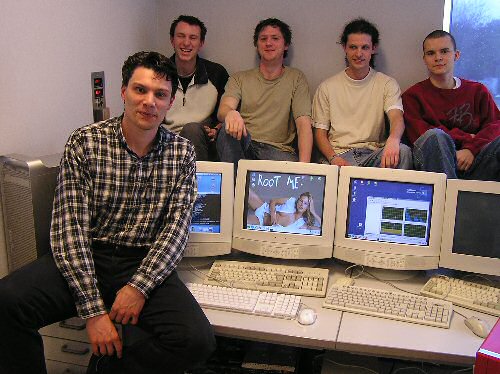No more mysteries: Apple's G5 versus x86, Mac OS X versus Linux
by Johan De Gelas on June 3, 2005 7:48 AM EST- Posted in
- Mac
Benchmark configuration
We used the MySQL version (4.0.18) that came with the SUSE SLES9 CD's and Mac OS X Tiger 10.4.1, which was certified to work on our OS.Software: Intel, AMD
SUSE SLES 9 (SUSE Entreprise Edition) , Linux kernel 2.6.5, 64 bit.
Workstation tests: Windows XP SP2
Software: Apple PowerMac G5
OS X 10.4.1 Tiger, 64 bit (partially).
Software: common
MySQL 4.0.18, 32 and 64 bit, MyISAM engine
Gcc 3.3.3
Hardware
Here is the list of the different configurations:Apple PowerMac Dual 2.7 GHz, Dual 2.5 GHz
4 GB (8x512 MB) Corsair XMS3200 running at CAS 3-3-3
Intel® Server Board SE7520AF2
4 GB (4x1024 MB) Micron Registered DDR-II PC2-3200R, 400 MHz CAS 3, ECC enabled
NIC: Dual Intel® PRO/1000 Server NIC (Intel® 82546GB controller)
Dual Xeon DP Galatin 3.06 GHz 1 MB L3-cache, 533 MHz FSB
Intel SE7505VB2 board - Dual DDR266
2 GB (4x512 MB) Crucial PC2100R - 250033R, 266 MHz CAS 2.5 (2.5-3-3-6)
NIC: 1 Gb Intel RC82540EM - Intel E1000 driver.
Opteron Server: Dual Opteron 250 (2.4 GHz)
Iwill DK8ES Bios version 1.20
4 GB: 4x1GB MB Reg. Transcend (Hynix 503A) DDR400 - (3-3-3-6)
NIC: Broadcom BCM5721 (PCI-E)
MSI K8T Master1-FAR
4x512 MB infineon PC2700 Registered, ECC enabled
NIC: Broadcom 5705
Shared Components
1 Seagate Cheetah 36 GB - 15000 rpm - 320 MB/s
Maxtor 120 GB DiamondMax Plus 9 (7200 rpm, ATA-100/133, 8 MB cache)
Words of thanks
A lot of people gave us assistance with this project, and we like to thank them of course:Frank Balzer, IBM DB2/SUSE Linux Expert
Jasmin Ul-Haque, Novell Corporate Communications
Matty Bakkeren, Intel Netherlands
Trevor E. Lawless, Intel US
Larry.D . Gray, Intel US
Damon Muzny, AMD US

My team and I at the Technical University in the lab. Notice the slick Power Mac system behind me.
Bert Van Petegem, DB2 Expert
Ruben Demuynck, Vtune and OS X expert
Yves Van Steen, developer Dbconn
David Van Dromme, Iwill Benelux Helpdesk (http://www.iwill-benelux.com)
I also would like to thank Lode De Geyter, manager of the PIH, for letting us use the infrastructure of the TUK ( www.pih.be) to test the database servers.










116 Comments
View All Comments
Icehawk - Friday, June 3, 2005 - link
Interesting stuff. I'd like to see more data too. Mmm Solaris.Unfortunately the diagrams weren't labeled for the most part (in terms of "higher is better") making it difficult to determine the results.
And the whole not displaying on FF properly... come on.
NetMavrik - Friday, June 3, 2005 - link
You can say that again! NT shares a whole lot more than just similarites to VMS. There are entire structures that are copied straight from VMS. I think most people have forgotten or never knew what "NT" stood for anyway. Take VMS, increment each letter by one, and you get WNT! New Technology my a$$.Guspaz - Friday, June 3, 2005 - link
Good article. But I'd like to see it re-done with the optimal compiler per-platform, and I'd like to see PowerPC Linux used to confirm that OSX is the cause of the slow MySQL performance.melgross - Friday, June 3, 2005 - link
I was just thinking back about this and remembered something I've seenComputerworld has had articles over the past two years or so about companies who have gone to XServes. They are using them with Apache, SYbase or Oracle. I don't remember any complaints about performance.
Also Oracle itself went to XServes for its own datacenter. Do you think they would have done that if performance was bad? They even stated that the performance was very good.
Something here seems screwed up.
brownba - Friday, June 3, 2005 - link
johan, i always appreciate your articles.you've been /.'d !!!!
and anandtech is holding up well.
good job
bostrov - Friday, June 3, 2005 - link
Since so much effort went in to vector facilities and instruction sets ever since the P54 days, shouldn't "best effort" on each CPU be used (use the IBM compiler on G5 and the Intel compiler on x86) - by using gcc you're using an almost artifically bad compiler and there is no guarantee that gcc will provide equivilant optimizations for each platform anyway.I think it'd be very interesting to see an article with the very best available compilers on each platform running the benchmarks.
Incidently, intel C with the vector instruction sets disabled still does better.
JohanAnandtech - Friday, June 3, 2005 - link
bostrov: because the Intel compiler is superb at vectorizing code. I am testing x87 FPU and gcc, you are testing SSE-2 performance with the Intel compiler.JohanAnandtech - Friday, June 3, 2005 - link
minsctdp: A typo which happened during final proofread. All my original tables say 990 MB/s. Fixed now.bostrov - Friday, June 3, 2005 - link
My own results for flops 2.0: (compiled with Intel C 8.1, 3.2 Ghz Prescott with 160 Mhz - 5:4 ratio - FSB)flops20-c_prescott.exe
FLOPS C Program (Double Precision), V2.0 18 Dec 1992
Module Error RunTime MFLOPS
(usec)
1 1.7764e-013 0.0109 1288.7451
2 -1.4166e-013 0.0082 852.7242
3 8.1046e-015 0.0067 2531.7045
4 9.0483e-014 0.0052 2858.2062
5 -6.2061e-014 0.0140 2065.6650
6 3.3640e-014 0.0100 2906.2439
7 -5.7980e-012 0.0327 366.4559
8 3.7692e-014 0.0111 2700.8968
Iterations = 512000000
NullTime (usec) = 0.0000
MFLOPS(1) = 1088.7826
MFLOPS(2) = 854.7579
MFLOPS(3) = 1609.7508
MFLOPS(4) = 2753.5016
Why are the anandtech results so poor?
melgross - Friday, June 3, 2005 - link
I thought that GCC comes with Tiger. I have read Apple's own info, and it definitely mentions GCC 4. Perhaps that would help the vectorization process.Altivec is such an important part of the processor and the performance of the machine that I would like to see properly written code used to compare these machines.